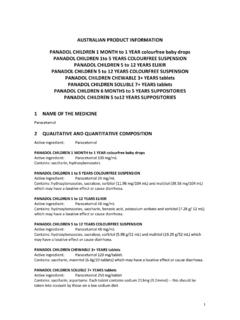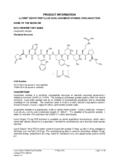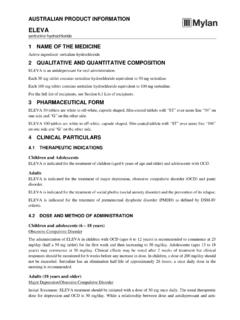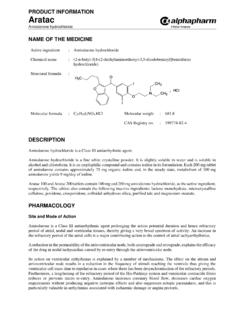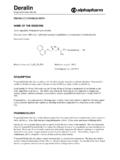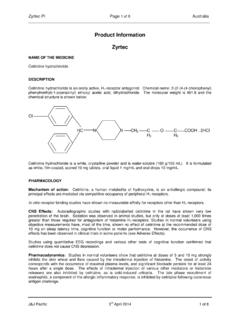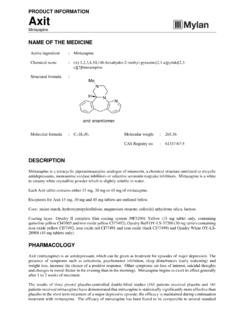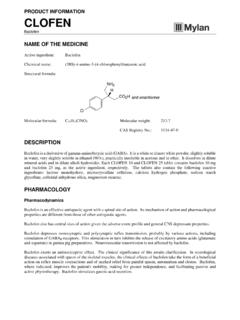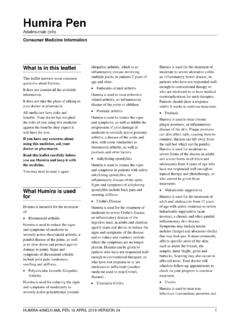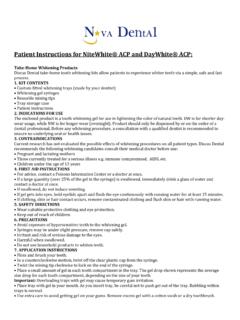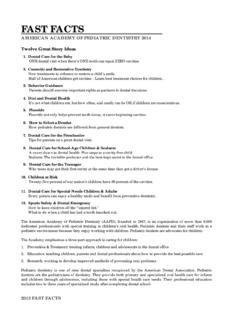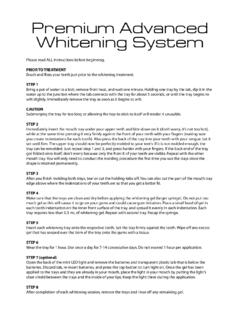Transcription of 1 NAME OF THE MEDICINE 2 QUALITATIVE AND …
1 This medicinal product is subject to additional monitoring in Australia. This will allow quick identification of new safety information. Healthcare professionals are asked to report any suspected adverse events at AUSTRALIAN PRODUCT INFORMATION. CABOMETYX (CABOZANTINIB) TABLETS 20, 40 AND 60MG. 1 NAME OF THE MEDICINE . Cabozantinib (S)-malate 2 QUALITATIVE AND QUANTITATIVE COMPOSITION. CABOMETYX tablets contain cabozantinib(S)-malate equivalent to either 20 mg, 40 mg or 60 mg of cabozantinib as the active ingredient. Cabozantinib (S)-malate is a white to off-white, non-hygroscopic, crystalline substance. It is practically insoluble above pH of 4 and in water.
2 For the full list of excipients, see section LIST OF EXCIPIENTS. 3 PHARMACEUTICAL FORM. CABOMETYX 20 mg film-coated tablets are yellow, round with no score, and debossed with XL on one side and 20 on the other side of the tablet. CABOMETYX 40 mg film-coated tablets are yellow triangle shaped with no score, and debossed with XL on one side and 40 on the other side of the tablet. CABOMETYX 60 mg film-coated tablets are yellow oval shaped with no score, and debossed with XL on one side and 60 on the other side of the tablet. 4 CLINICAL PARTICULARS. THERAPEUTIC INDICATIONS. Cabometyx is indicated for the treatment of advanced renal cell carcinoma (RCC) in adults following prior treatment with vascular endothelial growth factor targeted therapy.
3 DOSE AND METHOD OF ADMINISTRATION. Therapy with CABOMETYX should be initiated by a physician experienced in the administration of anticancer medicinal products. The recommended dose of CABOMETYX is 60 mg once daily. Treatment should continue until the patient is no longer clinically benefiting from therapy or until unacceptable toxicity occurs. Management of suspected adverse drug reactions may require temporary interruption and/or dose reduction of CABOMETYX therapy (see Table 1 and Section SPECIAL. CABOMETYX Product Information 1. WARNINGS AND PRECAUTIONS FOR USE). When dose reduction is necessary, it is recommended to reduce to 40 mg daily, and then to 20 mg daily.
4 Dose interruptions are recommended for management of CTCAE grade 3 or greater toxicities or intolerable grade 2. toxicities. Dose reductions are recommended for events that, if persistent, could become serious or intolerable. If a patient misses a dose, the missed dose should not be taken if it is less than 12 hours before the next dose. Table 1: Recommended CABOMETYX dose modifications for adverse reactions Adverse reaction and severity Treatment Modification Grade 1 and Grade 2 adverse reactions Dose adjustment is usually not required. which are tolerable and easily managed Consider adding supportive case as indicated.
5 Grade 2 adverse reactions which are Interrupt treatment until the adverse reaction intolerable and cannot be managed with a resolves to Grade 1. dose reduction or supportive care Add supportive care as indicated. Consider re-initiating at a reduced dose. Grade 3 adverse reactions (except clinically Interrupt treatment until the adverse reaction nonrelevant laboratory abnormalities) resolves to Grade 1. Add supportive care as indicated. Re-initiate at a reduced dose. Grade 4 adverse reactions (except clinically Interrupt treatment. nonrelevant laboratory abnormalities) Institute appropriate medical care. If adverse reaction resolves to Grade 1, re- initiate at a reduced dose.
6 If adverse reaction does not resolve, permanently discontinue CABOMETYX. Note: Toxicity grades are in accordance with National Cancer Institute Common Terminology Criteria for Adverse Events Version (NCI-CTCAE v4). Special populations Elderly patients No specific dose adjustment for the use of cabozantinib in older people ( 65 years) is recommended. Race There is little experience with cabozantinib in non-White patients. CABOMETYX Product Information 2. Patients with renal impairment Cabozantinib should be used with caution in patients with mild or moderate renal impairment. Cabozantinib is not recommended for use in patients with severe renal impairment as safety and efficacy have not been established in this population.
7 Patients with hepatic impairment In patients with mild or moderate hepatic impairment the recommended dose is 40 mg once daily. Patients should be monitored for adverse events and dose adjustment or treatment interruption should be considered as needed. Cabozantinib is not recommended for use in patients with severe hepatic impairment as safety and efficacy have not been established in this population. Patients with cardiac impairment There is limited data in patients with cardiac impairment. No specific dosing recommendations can be made. Paediatric population The safety and efficacy of cabozantinib in children and adolescents aged <18 years have not yet been established.
8 No data are available. Method of administration CABOMETYX is for oral use. The tablets should be swallowed whole and not crushed. Patients should be instructed to not eat anything for at least 2 hours before through 1 hour after taking CABOMETYX. CONTRAINDICATIONS. Hypersensitivity to the active substance or to any of the excipients (see Section LIST OF. EXCIPIENTS ). SPECIAL WARNINGS AND PRECAUTIONS FOR USE. As most events that require dose modification or interruption can occur early in the course of treatment, the physician should evaluate the patient closely during the first eight weeks of treatment to determine if this is necessary.
9 Events that generally have early onset include hypocalcaemia, hypokalaemia, thrombocytopenia, hypertension, palmar-plantar erythrodysaesthesia syndrome (PPES), proteinuria, and gastrointestinal (GI) events (abdominal pain, mucosal inflammation, constipation, diarrhoea, vomiting). Dose reductions and dose interruptions due to an adverse event occurred in and 70%, respectively, of cabozantinib-treated patients in the pivotal clinical trial. The median daily dose of cabozantinib was mg. Two dose reductions were required in of patients. The median time to first dose reduction was 55 days, and to first dose interruption was 38.
10 Days. CABOMETYX Product Information 3. Safety and efficacy of cabozantinib has not been evaluated in patients with NMYHA Class 3. or 4 Heart Failure and patients with endobronchial manifestations of RCC. Perforations and fistulas Serious gastrointestinal (GI) perforations and fistulas, sometimes fatal, have been observed with cabozantinib. Patients who have inflammatory bowel disease ( , Crohn's disease, ulcerative colitis, peritonitis, diverticulitis, or appendicitis), have tumour infiltration in the GI. tract, or have complications from prior GI surgery (particularly when associated with delayed or incomplete healing) should be carefully evaluated before initiating cabozantinib therapy and subsequently they should be monitored closely for symptoms of perforations and fistulas including abscesses.
